Life with the Lenovo Yoga 2 Pro
by Brett Howse on July 30, 2014 2:00 PM EST- Posted in
- Notebooks
- Lenovo
- Windows 8.1
- Yoga
High DPI display
I was rather impressed by the display on the Yoga 2 Pro. The 13.3” IPS touchscreen at 3200x1800 gives the Yoga 2 Pro one of the highest pixels per inch of any current Windows 8.1 device at 276 PPI. Running desktop applications at 3200x1800 can cause some issues, and if so the only solution at this time is to drop the resolution down to 1600x900. It usually depends on the application itself and whether it supports a HiDPI mode. Some play nice and some do not. As one might expect, in a modern application environment the high DPI brings crisp font rendering and a sense of clear graphics.
Application issues aside, all is not perfect with this display either. As we know from past reviews, high PPI devices can have a higher battery draw because the amount of backlight required to push the same amount of light through a dense display is simply higher. One solution to this problem is a Thin-Film-Transistor (TFT) made of Indium Gallium Zinc Oxide (IGZO), which can be thinner than the amorphous silicon of a standard TFT and offers better transparency than the standard TFT. Some devices (like the Razer Blade which is also 3200x1800) have chosen this method. Unfortunately, likely for cost reasons, the Yoga 2 Pro has chosen to go with an RGBW pentile pixel arrangement. The white subpixel is used to improve the brightness of the display without having to overpower the backlight, but it comes with a cost of color reproduction and contrast ratio. The early runs of the Yoga 2 Pro suffered from very bad yellows. Since the initial release, Lenovo has updated the device firmware and software to help compensate.
Out of the box image quality
With the white pixel, one of the biggest things to suffer is the contrast ratio. The maximum brightness of the screen is not very high to begin with, with 249 nits at 100% brightness. At that level of backlight, the black level is 0.5 nits, giving a meager 497:1 contrast. The brightness levels are fine for indoor use, but with blacks that bright it really hurts contrast and can be pretty noticeable when using this laptop.
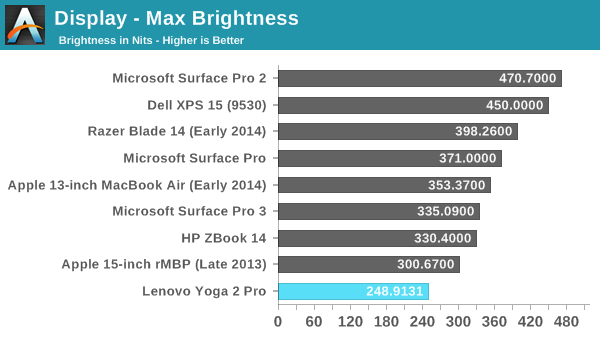
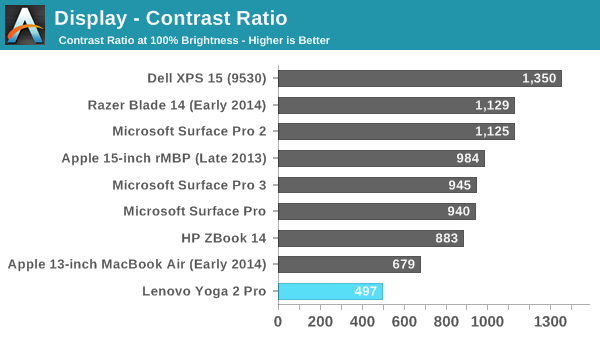
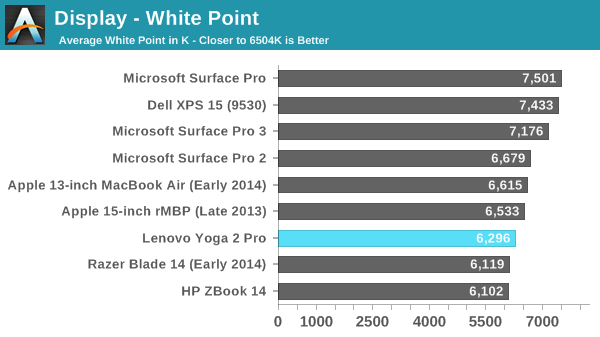
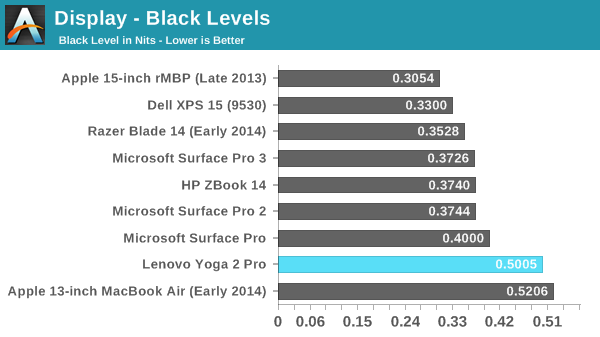
Contrast ratios aside, other elements of the display are pretty good for a consumer focused laptop. Out of the box, the greyscale DeltaE is an impressive 1.417. Blues are a bit low in the overall score, but only a bit.
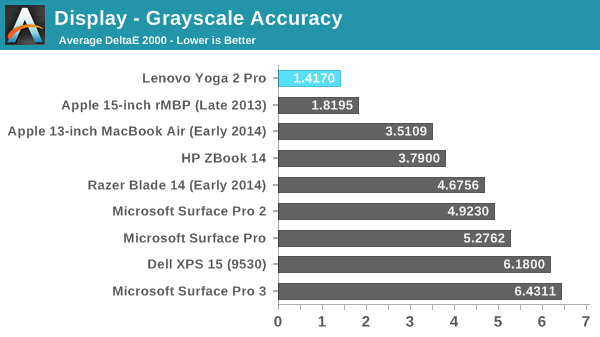
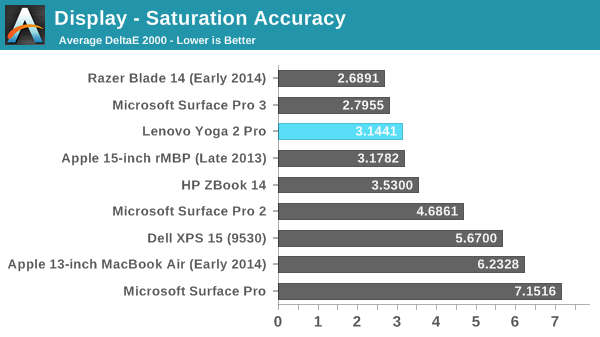
The uncalibrated saturation is also decent at 3.1441. There is definitely some drift, but it is not terrible. The yellows are spot on for saturation, which is a good sign after the firmware and software fixes to correct that. Cyan and Magenta are off, which is a theme going forward.
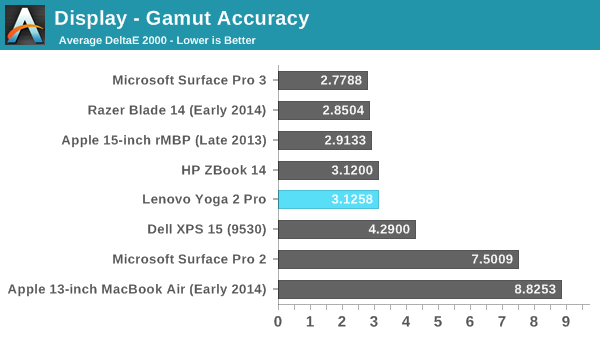
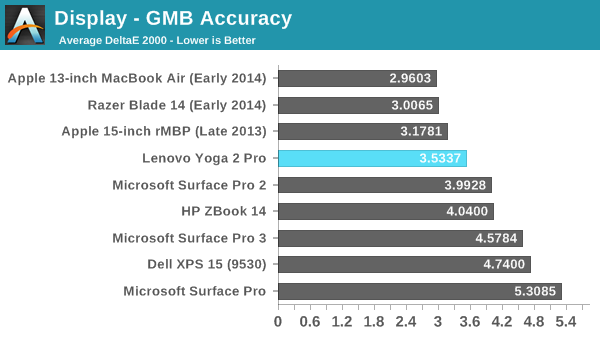
For the Gretag Macbeth colorchecker, we once again have a reasonable result of 3.5337. This device is not going to be suited for a professional image editor, but it is not really marketed as a professional device. We are looking for values under three, and the Yoga 2 Pro is close.
Calibrated image quality
Next up we will take a look at the display after it has been calibrated.
Once calibrated, the already great greyscale gets even better, with a DeltaE 2000 of 0.7834 and a white point of 6570, but that excellent result does not carry over to the rest of the display’s abilities. Cyan is again our biggest culprit, with it having a DeltaE of around 7 when the display is calibrated. This actually pulls the GMB score higher than the stock settings.
Display conclusion
Just looking at the device specifications, this should be a great display with such a high resolution. But the pentile nature of the screen can and does cause havoc with both blacks and colors. Unfortunately this display is just OK. If it was compared against most laptop panels of only a year or two ago, it would likely be a standout with both IPS and high resolution, but unfortunately it falls somewhat short. The color accuracy is not ridiculous (at least patched) but the contrast ratio really hurts, and as someone who really prefers black levels very low, it is very noticable how much light gets through on dark content. However to be fair, the redeeming quality of the display is the QHD+ resolution and to achieve that at the price point Lenovo wanted they chose to go with RGBW. It’s a compromise, but one that really does deliver on the crispness of text and images.


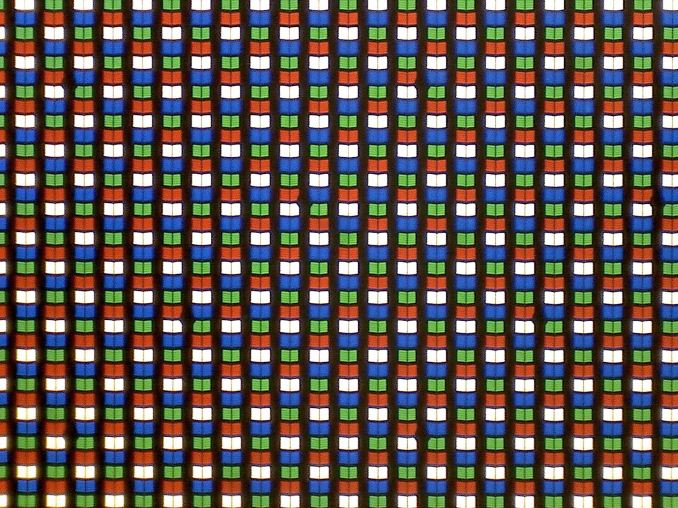
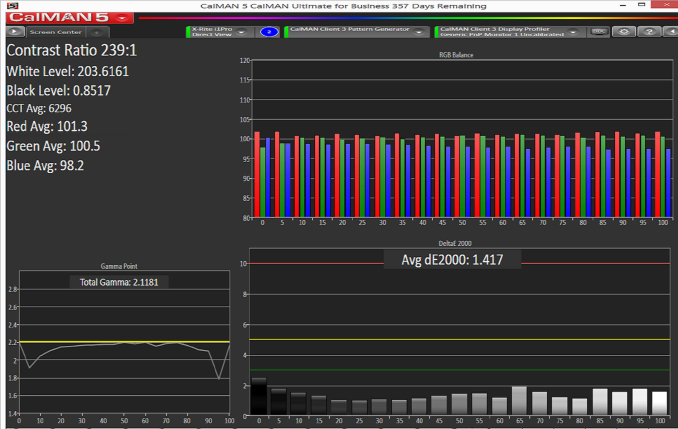





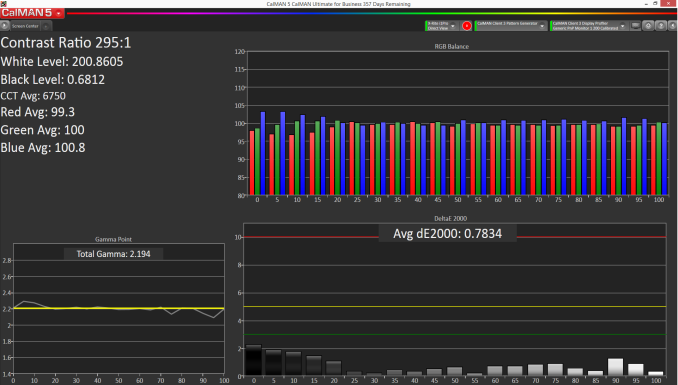











103 Comments
View All Comments
Brett Howse - Wednesday, July 30, 2014 - link
That's great to hear the Wireless is a real drawback on the unit we received. I'm still hoping they will get back to me with the time on when they switched it over. The specs on the website still show the old card so I can't guarantee someone will get AC at the moment.DrShawarma - Wednesday, July 30, 2014 - link
I've been reading this site for quite a while, but this will be my first post.I bought a Y2P about a month and ago and am surprisingly pleased. It's quick, fun and feels good in the hand.
I do however have 2 tiny complaints-
1) Adobe programs won't scale correctly, requiring a microscope to work with. Don't care about that too much though.
2) The trackpad is like a fingerprint\oil magnet, that on the other hand is driving me nuts, how do I clean it? (I tried an LCD cleaning solution with a towel, did nothing)
Brett Howse - Wednesday, July 30, 2014 - link
Adobe showed off their new products with High DPI support at the Surface Pro 3 launch I believe. That's been a big complaint of mine, especially since Adobe should be on top of this because their target market would likely benefit from HiDPI more than the average consumer. Looks like version 13 at the moment but of course that will mean an upgrade cost as well.HighImStan - Wednesday, July 30, 2014 - link
They have since updated their the CPU to i7-4510u and dual band wireless ac-7260 card. I just bought mine, manufactured in mid June, and it hasn't had any wifi issues. Also, uninstalling the McAfee bloatware helped. Still has the greenish yellow though on the display.DigitalFreak - Wednesday, July 30, 2014 - link
Supposedly it's better than it was, but it's just a side effect of the screen technology they chose to use.wpcoe - Wednesday, July 30, 2014 - link
I read that the RAM is soldered to the motherboard, so not user upgradable, but is the SSD user upgradable? I'd prefer the i3 model, but with a larger SSD.KingGheedora - Friday, August 1, 2014 - link
You can upgrade the SSD, it is M.2 slot though. But the SSD it comes with is surprisingly fast. I felt no need to upgrade it (512gb model).Samus - Wednesday, July 30, 2014 - link
My problem with the Yoga is the price. Although they can definitely be had for less than MSRP, they're still more expensive than a Surface 3 WITH a type cover. The rest of the specs, other than the screen size (obviously Yoga is two inches bigger) are about the same, but the Surface has more flexibility. One of my clients picked up both the Surface 2 Pro and a Yoga 2 back in March, and he likes the Yoga 2 more, and perceptively thinks its lighter.But I think the Surface 3 gives it a run for its flexibility.
HighImStan - Thursday, July 31, 2014 - link
I got the Y2P because my Surface Pro 2 was stolen. Originally, I was planning on waiting for the i7 Surface 3 to arrive in August but eventually settled on the Y2P because1) A 256 i7-4650u with HD5000 is $1549 + type cover $130. For around the price of the Y2P, I can only get 128 i5-4300u with HD 4400 $999 + type cover $130 and only 4gb of ram too! Y2P was only $1200 for i7-4510u with HD4400 and 8gb. I'm on a tight budget this month so Y2P got me the best bang for the buck.
2) My Surface 2 Pro kept having connection issues with the type cover. Brought it to Palo Alto's Microsoft store and they have no idea what was wrong. I played with some of the Surface 3 for an hour and found connection issues that was on and off with one of the displayed Surface 3. I was about to bring back my Surface Pro 2 for fixing after my Fourth of July vacation but it was stolen. So in a way, losing that device is a blessing in disguise...I was able to discover Y2P.
3) I never took off the type cover on my Surface Pro 2 anyways so the Y2P doesn't pose a problem. I treated the SP2 like the Y2P anyways by bending back the keyboard and using it as a laptop. Only difference, I don't have to worry about problems of keyboard connection. Only thing I miss from my SP2 is the mini display port (better than the micro hdmi imo) and the ability to change the keyboard lighting's brightness. Yes, it was lighter too but the weight of the Y2P never bothers me.
Samus - Thursday, July 31, 2014 - link
That's crazy about your connection issues. I have dozens of clients with Surface 2's and none of them mentioned that. A firmware update fixed some wifi issues people were having back in March though.As far as price, nobody pays retail for Surface. They can always be had for 20% less (just like the Yoga 2) but with that in mind, I agree that it's only really competitive at the base level. But that's where most people are buying, anyway.
I just picked up a Surface 2 256GB 8GB i5 for $800 new with a type cover on eBay... That was a buy-it-now too. There's a lot of auctions for used ones that include BOTH covers for even less.